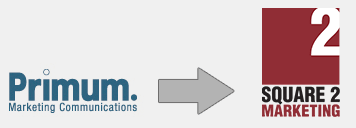
Turning Your Website Into A Lead Generation Machine
How To Start Getting Leads From Your Website
You’re reading this because you know something’s “just not right” with your marketing. You might not know what, but you know something’s off. You might not be getting enough or any leads from your website, your old-school tactics might not be doing what they used to do or you might be getting pressure from the higher ups to do something different.
Good news! This chapter is going to help. First, you need a shift in mindset. Your website is NOT an online brochure about your company; it’s an online resource center to help your prospects make a safe and smart purchase decision. Once you change your thinking and start managing your website as if it’s a resource center, you’ll start seeing many, many more leads.
We also want you to think about your website like Disney thinks about its rides. Disney creates an experience, and you need to do that too. The moment your visitors arrive on your website, they need to be saying WOW! They need to be educated, advised, coached and consulted along the way.
Every page should be strategically designed to answer their questions and provide them with more information. The better you do this, the more leads you’ll get from your marketing effort.
Here's how to go about doing what we’re talking about.
Upon Arrival – The Welcome Message
Your website has a simple agenda: to get someone you don’t know and have never met to give you their contact information. That’s it! It’s the same agenda as when you go to a party and you meet someone new. You want their contact information. If you stand there and talk about yourself all night, you won’t get their number. If you appear to care about them, if you ask them a lot of smart questions and if you take a legitimate interest in them, you might just get their number.
But first, you have to get their attention. The same is true for your website. If I arrive on your site and it looks like all the other sites in your industry, I’m going to be bored and hit the back button. If I arrive on your site and I can’t tell what you do, can’t easily view the site on my phone or find the site looks poorly designed, I’m hitting the back button. Here’s more bad news:
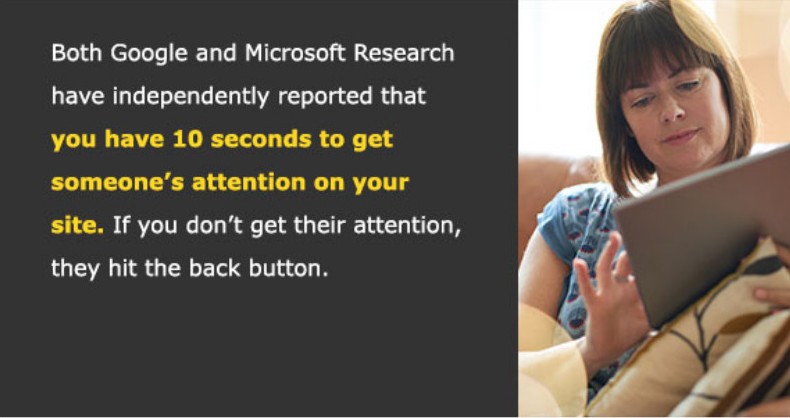
Face it; the cards are stacked against you.
This is why your home page is the most important marketing asset in the history of your company.
You have 10 seconds to tell me you understand me and my challenges, how you solve my challenges, what makes you different, why I should consider looking around and that you’ve helped other people just like me. Plus, you have to do it in an interesting, creative and digital way. Does this sound like an easy task? If it does, you don’t understand the task. This is the hardest marketing task you’ll ever work on. This is the reason we work so hard with our clients to get this part of their marketing right. It’s so important.
People don’t want to change, so you have to disrupt their status quo and grab their attention. People make purchase decisions emotionally, so you should connect with them emotionally on your site. People want to make the right, safe purchase decision, so you must educate them and help them feel like you actually want to help them with their decision. Your website has to do all of this and it has to do it better than all of your competitors.
Strategically Crafting The Experience
It’s so easy to leave your site, so the better the experience you provide visitors, the more leads you’ll get. Upon arrival, you have to give them the messages they need to feel like they’re in the right place. They have to start to know, like and trust your company.
Your site has to be easy to navigate on all devices. People are quick to give up when challenged or frustrated. Your site must be written in a way that is not too technical. People get nervous when they don’t understand everything in front of them. Your site needs to have a variety of media options. Some people like to read, but many others prefer to watch a video. If you have both, you’re going to be delivering an improved experience.
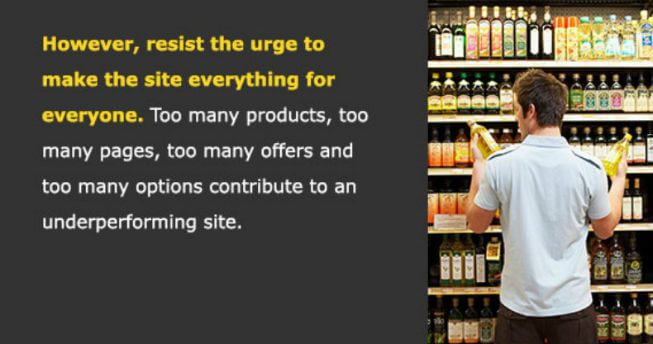
Remember, the site’s only mission in life is to generate leads.
Be sure to deliver a simple message that disrupts, emotionally connects and clearly articulates what you do. On our site, you learn that 90% of C-level execs do not respond to cold marketing. You see that we help people whose marketing is no longer working like it used to work. You see we’re an inbound agency that specializes in generating leads for our clients and you see some of the people we’ve helped. We have e-books, blog articles, whitepapers and other content that visitors can easily download. Finally, we have a few pages for people who want more information about inbound marketing, our team and our services. That’s it for our website.
Applying The Trio Of Offers
If 100 people come to your site today, most (usually around 90% of the people) are not ready to talk to you. One of the most frequent website mistakes people make is offering something that appeals to 10% of the people while ignoring the other 90%. People aren’t dumb; they know that “contact us,” “speak with a sales rep” and “request a consultation” are just sales calls in disguise. Plus, 90% of people are not ready to speak with anyone; they just want information as they’re still learning and researching.
I know you want sales-ready leads, but you can clearly see that only a small percentage of visitors are ever going to be sales-ready leads. You need something for all the other people who took the time to find you, look around your site or follow up on a friend’s referral.
The trio of offers helps ensure you have information for people at the top of the funnel (awareness stage), people in the middle of the funnel (consideration stage) and people in the bottom of the funnel (decision-making stage).
 The No-Risk Offer
The No-Risk Offer
This is perfect for people who are just beginning their buyer journey. They’re in the awareness stage, so they need information that helps them start to understand what you do and how you do it. What should they be thinking about as they learn about your industry? Typically, these offers are highly educational, like whitepapers, e-books, tip sheets and guides. In exchange for the content, you get their email address, plus maybe their name or their company’s name. That’s it. It’s too early to ask for more; you’re still getting to know each other, so they don’t trust you yet. The more you ask for here, the fewer leads you’ll generate.
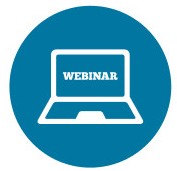 The Low-Risk Offer
The Low-Risk Offer
This is perfect for people in the consideration stage. They’ve been active in their buyer journey for a little longer and they’re looking at their options. They’ve bought into the concept and now they’re comparing providers. Typically, these offers require a greater time investment from the visitor. Webinars are a great middle-of-the-funnel offer. Other offers for the consideration stage might include online quizzes, polls, assessments or calculators. Because they’re considering you, the prospect/visitor is willing to give you more information. You can capture their company’s name, annual revenue, phone number, etc. They aren’t ready to talk to you, but they’re willing to put aside an hour to attend your webinar with the hope that you’ll continue to teach them something more.
The Direct Business Offer
Is this where we ask them to contact us? No, but you’re close. People in the decision-making stage are ready to talk to a sales rep, but they don’t want to be sold, so you have to do something for them. You have to offer them something of value to get them to put aside the time and schedule a call. In our case, we’ll grade their website and their ability to get found on search engines, and then provide a list of steps they can take to improve their score. We’ll also help them figure out how many leads they need to hit their revenue goals and offer some steps for improving their lead generation efforts.
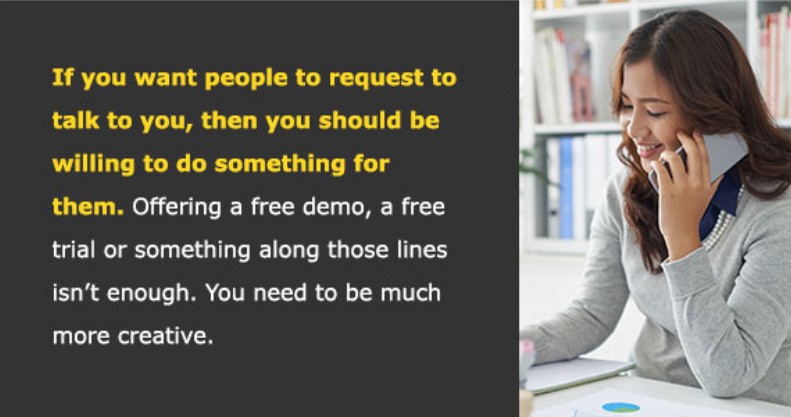
Continuously Improving The Experience
Your website is no longer a one-and-done project that you work on every three years. If you ever go through a major website rebuild again, you’re doing it wrong. Your website needs to be a living, breathing organism that gets constant attention every month. No more than a few weeks should go by without you testing out a theory on the site or making some type of upgrade, update, adjustment or improvement.
This means you need to be budgeting money to complete these upgrades every single month. Pages need to be added, messaging must be tested or adjusted to improve performance, offers should be tested for conversion and navigation needs to be adjusted to deliver a better experience. The work is never done.
By looking at your website in this way, you’ll also start looking at your website as a company asset with very specific performance metrics. Each month the site needs to deliver more visitors and more leads through an increased site-wide conversion rate. Just like your best salesperson, if the site is not improving month over month, you’re doing something wrong and it needs to be corrected.
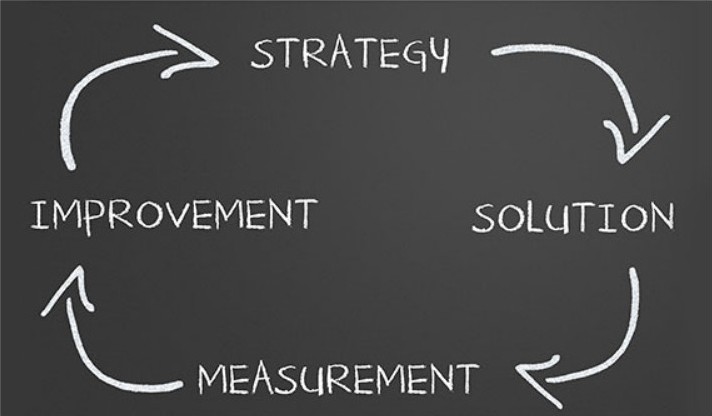
Once you get into the rhythm of tracking your site monthly and monitoring it for performance, you’ll start to make improvements to impact those results. This continuous improvement approach is a big part of inbound marketing and one of the secrets to getting results from inbound.
You should also consider applying technology to deliver a better experience. Did you know that with some of the marketing automation tools you can change what different people see on your site? With smart content, I can show different personas different messages, different pictures and different offers to deliver a more personalized experience.
Using Data To Drive More Leads
Inbound marketing is a data-driven, results-oriented marketing methodology — the only one on the planet. This means there is a ton of data that can be used to make improvements to your site almost every single day. You don’t have to argue with your boss about where the picture should go or what picture to use. Just pick one and let it run for a week. Then, swap it out for the other picture and let that run for a week. After two weeks, compare the results.

If the page with your picture got more clicks, produced more leads and saw more visitors over the seven days it ran compared to your boss’s picture, then you were right and your picture stays. Now, you work to outperform the control. Whatever improvements you apply that increase performance become the new normal, the new baseline or the new benchmark, and everything else should outperform those metrics.
As you look at your company’s website, here’s what you need to do today to get leads tomorrow:
- Create a compelling message on the home page that disrupts status quo, communicates what you do and explains how you do it differently than anyone else in your field.
- Make sure that you’re delivering an experience on your website that works on all devices and emotionally connects with your visitors.
- Use offers on your website to convert visitors into leads. The offers need to be perfectly tailored for people in the awareness, consideration and decision-making stages of their buyer journey.
- Make sure the site is about your prospects and not about you. Make sure it’s full of educational resources so your visitors get to know, like and trust you right from your site.
- Start setting performance expectations for the site and keep track of these metrics daily. Then, work every single week to make small improvements to the site so that you never have to rebuild the site again.
These simple five steps will ensure you create a website that turns visitors into leads and then leads into new customers for your company. Get started today!
 The No-Risk Offer
The No-Risk Offer









